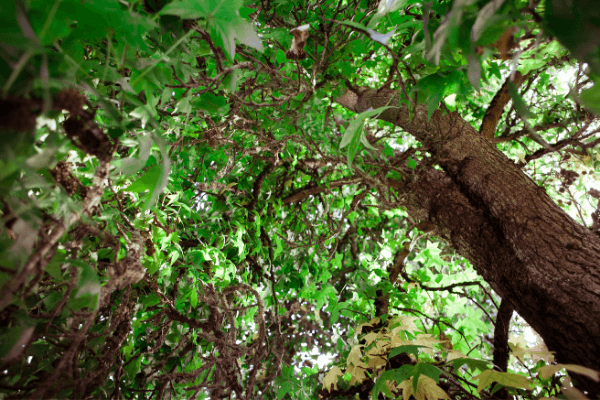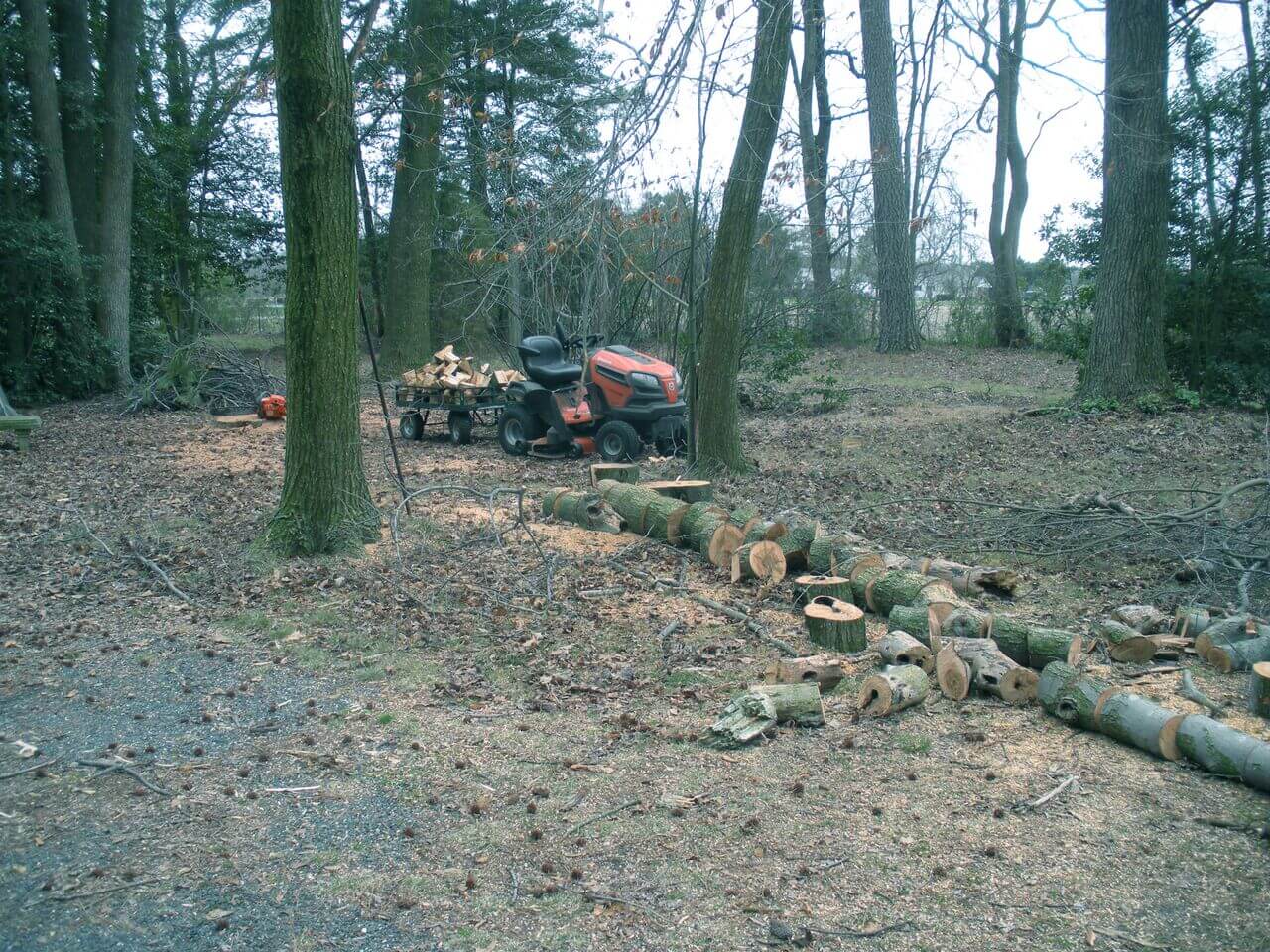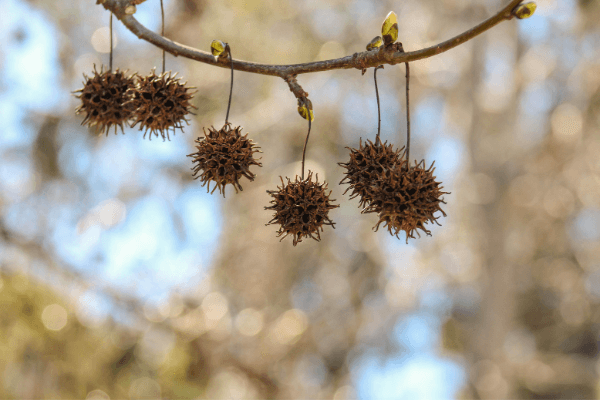- Home
- Firewood Types
- Sweet Gum Firewood
Sweet Gum Firewood
This post may contain affiliate links so I earn a commission.
There are many people who choose not to burn sweet gum firewood.
Since the wood is difficult to split and stack compared to other popular firewood types, some view it as a waste of time and energy.
Firewood is a topic of many different opinions.
Just because sweet gum might not be the best firewood around doesn't mean you can't use it.......it just takes a little more effort.
Sweet gum trees are found throughout the eastern United States.
It's considered a valuable tree used for lumber and furniture production, as well as for ornamental purposes.

The wood has a unique reddish brown color with sapwood that's nearly white and black grain running through the hardwood.
The wood is beautiful and it's often used as a veneer for plywood.
The one disadvantage to the wood is its grain which tends to warp really bad when it dries.
Easily identified by its star shaped leaves with 5 points and spiked fruit, these hardwood trees can grow up to 150 feet tall and live for up to 400 years.
Many people associate sweet gum with their hard spiked fruits that fall everywhere around the tree.
The fruit opens up which releases the seeds, however, the spiked shells are left behind and are often considered a nuisance.
The spiked shells can be painful to walk on and are commonly nicknamed burr balls or sticker balls.
Sweet Gum Firewood Use
Sweet gum is not a very popular firewood choice for a variety of different reasons. However, this doesn't mean you can't use the wood.
In fact, sweet gum will produce approximately 20.6 million BTU's per cord which isn't all that bad.
The major concern with the wood is the amount of work and energy it takes to split it into usable sizes.
 Cutting Sweet Gum Firewood
Cutting Sweet Gum FirewoodSweet gum firewood is hard to split......really hard.
Actually, it doesn't really split it just tears, shreds and twists its way apart.
If you're going to split sweet gum, using a hydraulic splitter is the best way.
Even with help from the splitter, handling sweet gum is time consuming.
For best results, try splitting the wood when it's still green.
If you don't have access to a power splitter, use a sharp splitting axe and work your way around the edges shaving off thin chunks as you go.
Avoid splitting the wood right down the center and just focus on the edges.
A visitor from Maryland shared a method he uses to make splitting the wood easier.
"This winter I discovered by pure chance a way to alter the wood fibers some so you can split the wood more effectively with an axe.
I left several large trunk cuts out in the snow in my yard through January and February.
Now this is Maryland, so we're not as cold as a Michigan winter, but both 2013-14 and 2014-15 were harsh so temperatures were sub-freezing for weeks.
The wood became super-saturated and froze up. I was able to split these pieces fairly well with my splitting-head axe.
Of course, "fairly effectively" with gum still means it was the hardest wood you'll ever split, except for elm, but it was an improvement over the norm.
I'm not sure if this will be useful for everyone, but the information might be helpful for someone around Maryland where sweet gum is one of the four most abundantly growing trees.
There's tons of it here, but not much of it is taken because of the interlocking wood fibers."
- Rick from Maryland
Another visitor shared these tips when splitting the wood by hand:
"I've been burning wood since we lived way North where hard maple was the ultimate. Now I use whatever there is.
Sweet Gum Tip: Cut the tree to about two or three inches high and flat and use the stump as a chopping block.
Cut the segments of wood to half their normal length and split it green if the wood is still moist and gum is worth the trouble.
It's a light wood and heats up fast on cold mornings. I use a heavy maul and the pieces split on the first swing.
I've been told Gum is hard to beat for baskets but the local basket making factory here shut down years ago."
-Heywood
Once the wood is split, store it under a roof or cover because sweet gum tends to rot quickly and produce mold when it's exposed to moisture.
Let the wood season for about 1 year and it will be ready to burn.
Sweet gum works good for the "shoulder seasons" when the outside temperatures are mild.
Since the wood burns quickly and doesn't have good coaling qualities, mixing it with other hardwoods will give you better overnight results.

Many people compare the burning qualities of sweet gum firewood to pine firewood except sweet gum does not contain the sticky sap that's associated with pine.
It burns fast and hot and creates a lot of ashes.
When you throw a piece of sweet gum on the fire you'll probably notice heavy smoke in the beginning before it fully ignites.
Sweet gum firewood tends to give off a lot of smoke and it even has an unpleasant odor at times.
Overall
Many people will not waste their time cutting, splitting and stacking sweet gum firewood.
They would rather use their time and storage space on a wood that's more "user friendly."
However, sweet gum does give off a decent amount of heat and the wood is capable of heating your home.
If you have access to free sweet gum that's already processed or if you cut down a single tree in your yard and you need to get rid of the wood, sweet gum is fine to use.
If you need a lot of firewood I would suggested avoiding sweet gum.
The wood takes about 3 times longer to process compared to other firewood types resulting in a lot of work for a small amount of firewood.

About the Author
Obsessed with firewood, Nick is behind over 350+ of Firewood For Life's articles, as well as countless reviews, guides and YouTube videos to help readers like you reduce heating costs and create the perfect fire.


